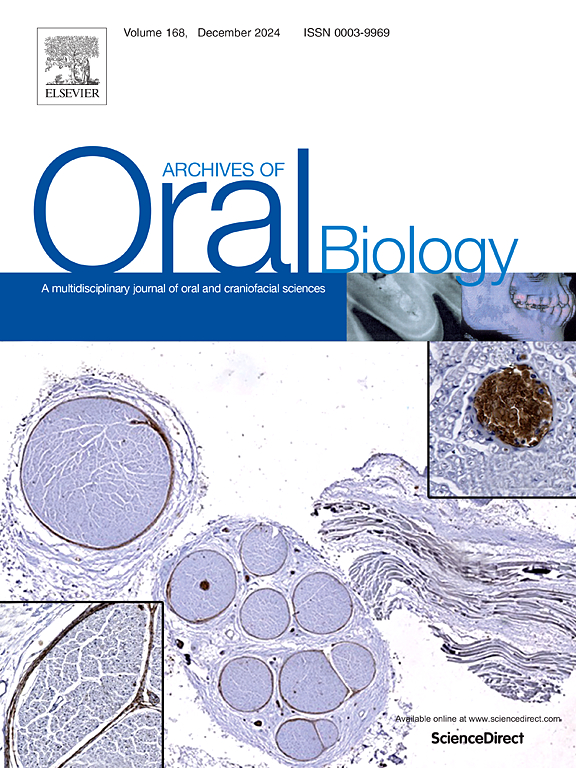军队士兵高强度体能训练前后口腔微生物学特征
IF 2.1
4区 医学
Q2 DENTISTRY, ORAL SURGERY & MEDICINE
引用次数: 0
摘要
目的探讨1个月高强度训练后士兵口腔微生物群及代谢水平的变化。设计采集10名口腔卫生习惯良好的士兵训练前后的唾液样本。随后,对口腔微生物组进行DNA提取、宏基因组测序和系统发育分析。结果20份样本共检出已知细菌113门2017属7733种。训练前后唾液微生物的多样性和丰富度相似(p >; 0.05),而beta多样性分析显示门和属水平上的微生物群结构差异(p <; 0.05)。高强度训练后士兵唾液中变形菌属、奈瑟菌属、脑莫球菌属、艾肯菌属等27个属的相对丰度显著增加(p <; 0.05)。相反,Bacteroidota、Veillonella、Parvimonas micra、Prevotella oris、Peptostreptococcus、Treponema等20个属的相对丰度下降(p <; 0.05)。在代谢水平上,训练导致氨基酸代谢、硫代谢、谷胱甘肽代谢和酪氨酸代谢等各途径的相对增加(p <; 0.05)。相比之下,训练后碳水化合物代谢、聚糖生物合成、代谢、HIF-1信号通路和坏死下垂相对降低(p <; 0.05)。结论通过1个月的高强度训练,揭示了士兵唾液微生物组的变化,其中牙周病、龋齿等口腔疾病的生物标志物相对丰度显著降低,以胃链球菌、口普氏菌、密螺旋体等为代表,提示长期高强度训练可能对口腔健康有积极作用。本文章由计算机程序翻译,如有差异,请以英文原文为准。
Characteristics of oral microbiomics with soldiers in the army before and after high-intensity physical training
Objectives
This paper aims to investigate the changes in soldiers' oral microbiome and metabolic levels after a month of high-intensity training.
Design
We collected saliva samples from 10 soldiers with good oral health and hygiene habits before and after training. Subsequently, DNA extraction, metagenomic sequencing, and phylogenetic analysis of the oral microbiome were conducted.
Results
7733 bacterial species from 113 known bacterial phyla and 2017 genera detected in 20 samples. The diversity and richness of saliva microorganisms before and after training were similar (p > 0.05), while beta diversity analysis showed structural differences in microbiota at the phylum and genus levels (p < 0.05). The relative abundance of 27 genera such as Proteobacteria, Neisseria, Morococcus cerebrosus and Eikenella in soldiers' saliva significantly increased after high-intensity training (p < 0.05). Conversely, the relative abundance of 20 genera such as Bacteroidota, Veillonella, Parvimonas micra, Prevotella oris, Peptostreptococcus, and Treponema decreased (p < 0.05). At the metabolic level, training resulted in a relative increase (p < 0.05) in various pathways, including amino acid metabolism, sulfur metabolism, glutathione metabolism, and Tyrosine metabolism. By comparison, after training, carbohydrate metabolism, glycan biosynthesis, metabolism, the HIF-1 signaling pathway, and necroptosis revealed a relative decrease (p < 0.05).
Conclusions
This paper reveals the changes in the saliva microbiome of soldiers after one month of high-intensity training, in which the relative abundance of biomarkers of periodontal disease, caries, and other oral diseases represented by peptostreptococcus, prevotella oris, treponema, etc., are significantly reduced, suggesting that long-term high-intensity training may have a positive effect on oral health.
求助全文
通过发布文献求助,成功后即可免费获取论文全文。
去求助
来源期刊

Archives of oral biology
医学-牙科与口腔外科
CiteScore
5.10
自引率
3.30%
发文量
177
审稿时长
26 days
期刊介绍:
Archives of Oral Biology is an international journal which aims to publish papers of the highest scientific quality in the oral and craniofacial sciences. The journal is particularly interested in research which advances knowledge in the mechanisms of craniofacial development and disease, including:
Cell and molecular biology
Molecular genetics
Immunology
Pathogenesis
Cellular microbiology
Embryology
Syndromology
Forensic dentistry
 求助内容:
求助内容: 应助结果提醒方式:
应助结果提醒方式:


